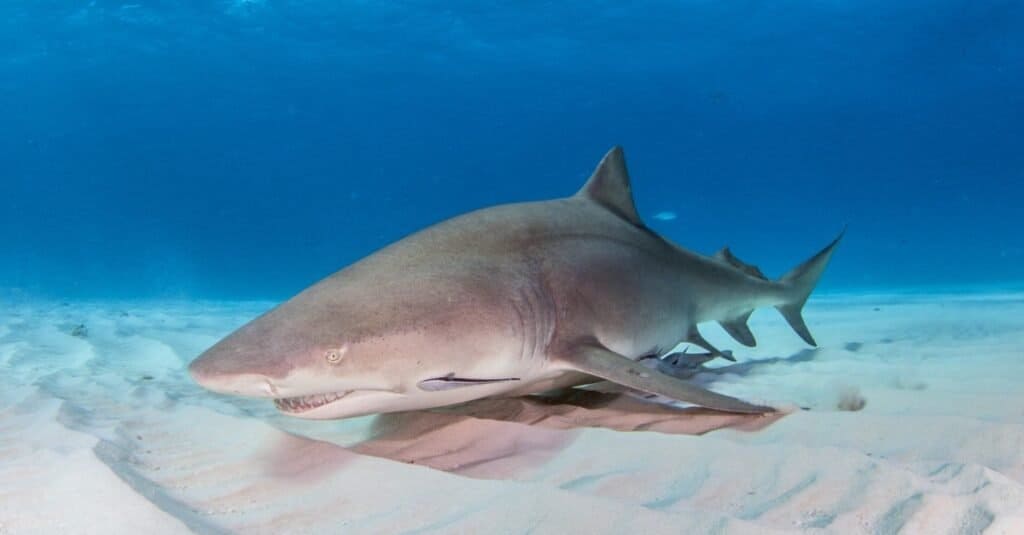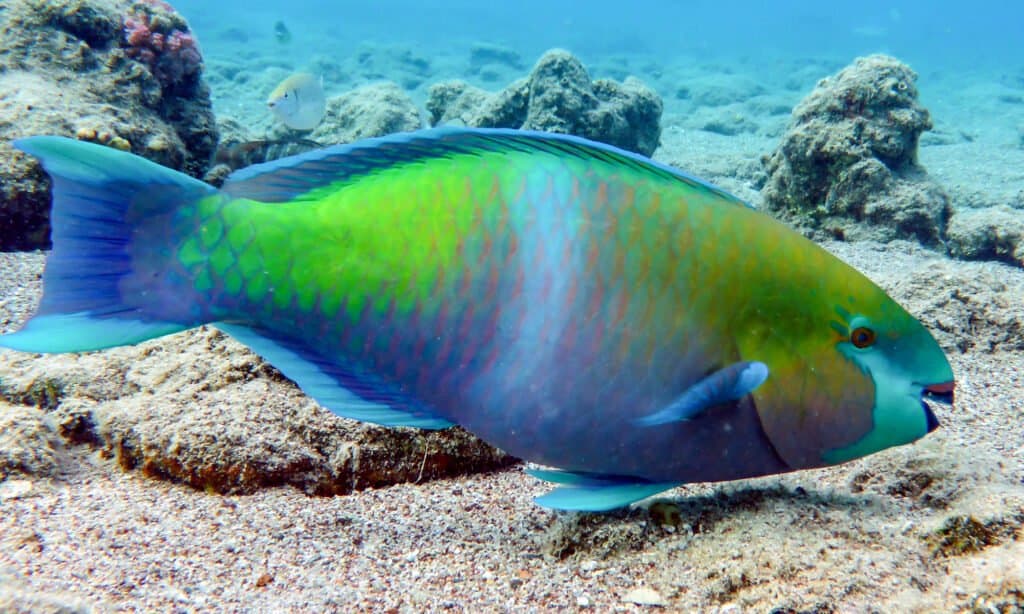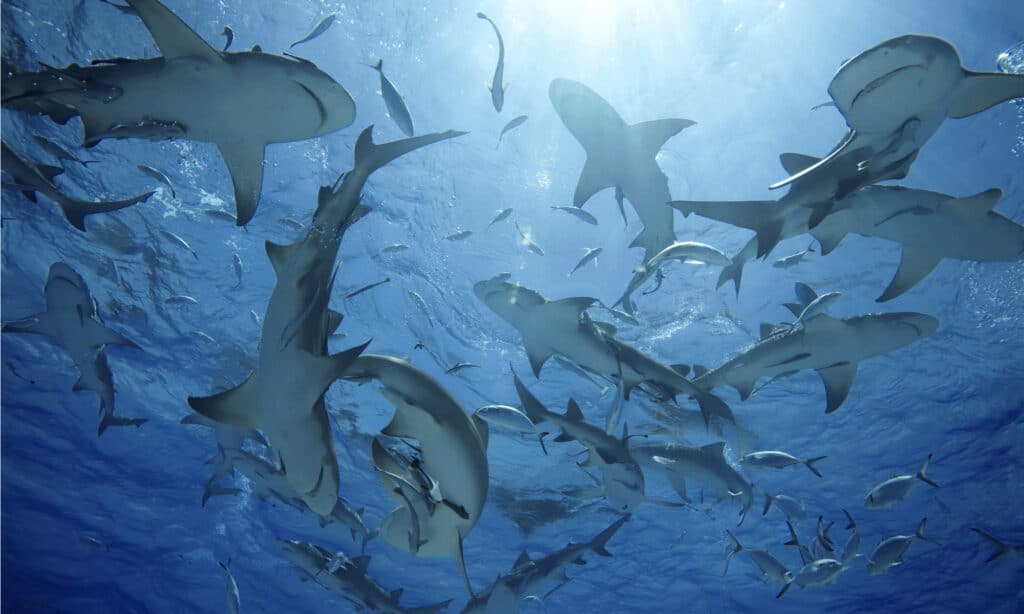Key Points:
- Lemon sharks typically measure between 8-10 feet long, with the longest recorded being a whopping 12 feet long. They can weigh up to 500 lbs.
- Some lemon sharks play dead when they are flipped on their backs. They can go limp and remain still for a period of time, and some will even display body tremors and heavy breathing.
- The yellowish coloring of lemon sharks aids in camouflaging them as they can blend into the sandy ocean floor while they hunt.
Like many different types of sharks, Lemon Sharks are large and intimidating. Lemon sharks are large, powerful predators, with rows of extremely sharp teeth. There are not many animals that would actively choose to take on a lemon shark, and even fewer who may survive to tell the tale. Even at the top of the food chain in Florida, however, lemon sharks have developed a rather shocking defense: they play dead!
Let’s take a deeper look at these fascinating ‘Zombie Sharks’ that are found in beaches across Florida.
What Do Lemon Sharks Look Like?

Lemon sharks common in Florida. These sharks are named for their yellow-brown skin that helps them camouflage in the sandy, tropical waters they inhabit.
©Michael Bogner/Shutterstock.com
The largest lemon shark ever recorded grew to an astounding 12 feet in length! On average, however, lemon sharks usually measure between 8-10 feet long, and female sharks are slightly larger than male sharks. These sharks have stocky, powerful bodies with short snouts. However, instead of the common “torpedo” body shape that many other shark species have, lemon sharks have flatter bodies. This unique body shape is helpful for lemon sharks as they forage in shallow waters along the ocean floor.
The name “lemon shark” comes from the color of the shark’s body. Lemon sharks are yellow, or at least a yellowish-brown color. This yellowish coloring helps lemon sharks to camouflage and expertly blend into the sandy ocean floor as they hunt. Besides their namesake yellow coloring, lemon sharks can also be easily identified by their distinct dorsal fins. Lemon sharks have two triangular-shaped dorsal fins that are almost the same size: one on the middle of the back, and one a little further down near the tail.
Why Lemon Sharks Can Become ‘Zombie Sharks’
Lemon sharks rule the top of the food chain and have no natural predators. A full-grown adult lemon shark can grow up to 11 feet in length and weigh up to 550 pounds! These sharks live and hunt in shallow waters. They are excellent swimmers with rows and rows of deadly sharp teeth at their disposal. So why would such a powerful predator need another line of defense?
But the lemon shark has one more defensive trick hiding up its fins: when a lemon shark is flipped onto its back, it plays dead! Some lemon sharks will instantly go limp and remain still. Others will add to the drama with heavy breathing and body tremors. These sharks can “play dead” on their backs long enough that scientists have been able to conduct studies and take measurements without trouble.
Why do these zombie-like sharks play dead? Scientists are still not entirely sure, especially since lemon sharks do not have any natural predators. However, some scientists have theorized that perhaps a lemon shark becomes disoriented when laying on its back. In such a vulnerable position, the shark may choose to “play dead” until it can re-orient itself and feel safe once again.
So if you see a “zombie shark” that appears dead suddenly rise, your eyes are not fooling you! This is likely a lemon shark rebounding from its tonic immobility.
Where Do Lemon Sharks Live?
Lemon sharks live in the Atlantic Ocean and the Pacific Ocean, primarily in warm, subtropical waters close to shore. Although these sharks can swim in ocean depths up to 300 feet deep, they typically live and hunt in waters that are no deeper than 150-200 feet. Lemon sharks prefer shallow waters with rocky or sandy bottoms and little to no vegetation, and younger sharks especially prefer mangroves. These sharks often hunt in bays and estuaries, around ocean reefs, and along docks. Sometimes lemon sharks will simply rest on the sandy ocean floor without moving.
Lemon sharks are often found in ocean waters from New Jersey in the United States, down to southern Brazil. Smaller populations of lemon sharks also live along the Ivory Coast and Senegal, as well as from southern Baja down to Ecuador. The highest number of lemon sharks, however, live in the ocean waters around the Bahamas and Florida. Lemon sharks are especially common in the shallow waters of southeastern Florida, often together in large groups. These sharks can also travel into freshwater and river mouths on occasion, but not nearly as far upstream as bull sharks.
In one particular study of sharks around Florida, researchers found that lemon sharks were the third most common shark off the coast of Florida behind nurse sharks and blacktip sharks.
Lemon Shark Nurseries
Breeding season for lemon sharks occurs in the spring and summer. Lemon sharks are polyandrous, so a single female shark will mate with multiple male sharks and give birth every other year. After a 12-month gestation period, a pregnant female lemon shark returns to the shallow area where she was born, often in a mangrove bay. Here she will give birth to 2-18 live baby sharks, or “pups,” before returning to the deeper ocean.
Lemon shark pups are typically 20-30 inches long and are independent as soon as they are born. The shark pups will stay in the “nursery” area where they were born until they are at least 3 feet long. Even after they leave, lemon sharks remain close to their original birthing or nursery area for several more years, grouping together with their littermates and other young lemon sharks. Lemon sharks do not reach sexual maturity until they are at least 12-13 years old.
What Do Lemon Sharks Eat?

Lemon sharks prefer bony fish that are easy to catch, like the parrotfish that live in coral reefs and seagrass beds.
©FromMyEyes/Shutterstock.com
Most shark species are opportunistic hunters, eating whatever is available at the time. Lemon sharks, on the other hand, are more selective in their diet. These sharks have demonstrated obvious preferences when it comes to mealtime. Lemon sharks primarily eat bony fish and will even target certain species of medium-sized fish that are easier to catch. For example, lemon sharks in the Bahamas often selectively target mojarras and parrotfish. Although they prefer bony fish, lemon sharks will also eat crustaceans, mollusks, and rays. On occasion, lemon sharks may also eat younger, smaller sharks. Young lemon sharks eat smaller animals like shore crabs and prawns until they grow bigger.
Lemon sharks hunt along the ocean floor and in the shallow waters along the shore where there are abundant schools of fish. When they attack, lemon sharks speed toward their prey, stopping suddenly as soon as they ram into the animal. The shark jabs at the animal and grabs it securely in its teeth, shaking its head side to side in order to pull chunks of flesh from its prey. This hunting style commonly causes “feeding frenzies” as other lemon sharks detect the torn-up flesh and quickly join in.
Lemon sharks often hunt at night when it is dark and harder to see. However, these sharks use unique olfactory and electromagnetic senses to hunt and track down prey. As marine animals move through ocean waters, they generate electrical currents. Lemon sharks have electroreception pores along their snouts that allow them to sense and track these electrical currents.

You might notice that lemon sharks often have fishy hitchhikers hanging on their bodies. These are remora fish, and Lemon sharks do not eat them. Instead, remoras and lemon sharks live together in a symbiotic relationship. The remoras, also known as “shark suckers”, hang onto lemon sharks and clean the sharks’ skin with their sucker-like mouths. They also act as excellent clean-up crews when lemon sharks eat, snatching any extra mess that the shark leaves behind after dinner. This benefits the lemon shark, as the remoras help to keep infections away by cleaning its skin clean. And of course, the remoras benefit by having a giant lemon shark bodyguard, as well as an easy meal.
Are Lemon Sharks Dangerous?
Lemon sharks are surprisingly docile, despite their large size. Their teeth are sharp and dangerous of course, and they are quite powerful. However, lemon sharks are typically uninterested in humans. In fact, there has never been a single fatal attack by a lemon shark on a human in recorded history. According to the International Shark Attack File, there have only been 10 lemon shark attacks on humans ever recorded, and none of them were fatal. In general, lemon sharks are harmless to humans, and many tour groups even take visitors on diving trips to see lemon sharks in Florida.
Social Sharks

Lemon sharks are extremely social and form groups of 12-20 sharks.
©Yann hubert/Shutterstock.com
Lemon sharks are one of the few types of sharks that form groups for sociality. These sharks group together based on size rather than on gender (smaller sharks avoid grouping with larger sharks so that they do not become someone’s next meal). Groups can be large, although there are rarely more than 20 sharks in a single group. Lemon sharks have brains similar to many types of mammals, and scientists believe that this allows them to socially learn from interacting and cooperating with one another. In other words, lemon sharks do not only form social groups for a hunting advantage. Lemon sharks also group together to form social bonds and to support and learn from one another.
Threats and Conservation Status
Lemon sharks are listed as “Vulnerable” and “Near Threatened” by the International Union for Conservation of Nature. Their declining populations are due to habitat loss and humans. For example, coral reefs are a favorite breeding habitat for lemon sharks, but many of these areas have been lost due to bleaching and damage from climate change. In addition, humans hunt lemon sharks for their meat, fins, and skin. Commercial and industrial fisheries also accidentally catch and kill lemon sharks when they become tangled in their nets.
The photo featured at the top of this post is © Greg Amptman/Shutterstock.com
Thank you for reading! Have some feedback for us? Contact the AZ Animals editorial team.






